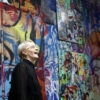
New poetry collection from Carolyn Oliver
In her new collection of poetry “The Alcestis Machine” (Acre), Carolyn Oliver tracks paths between the here we know and the gaping strange elsewhere — not just other places but other times, other galaxies, other realities. There’s a sepulchral mood to these wry and fertile poems, and Oliver bends the real, as when the angel of death comes into the flower shop for bluebells and leaves with hollyhocks. There’s a repeated imagining of another life. “In another life we were orchards.” “In another life I’m a vampire biographer.” Humor crackles on slant, a funny-weird excavation of the underworlds: “Lately I have been the energy of the kitefin shark, that enormous-eyed, fatty-livered slow cruiser of the mesopelagic depths.” And Oliver is deeply skilled at the pleasure phrase — “tulips puckered in shadow, expecting / daylight’s long lick” — and the gorgeous imploring: “Cover me like a cathedral,” she writes. Taken as a whole, the collection has a feel of translations from the untranslatable elsewhere, from the “alien languages.” She’s writing dispatches from the edge of things, from the fossilized past, pulling something from the patient-impatient depths of time and dirt, something “drawn unwilling from the dark holds of earth / and sea.” Maybe, in the end, it’s Desire that she draws from, in its galactic limitlessness and possibility. “Time comes first; desire follows in the distance.”
Anthropologist Rafael Schacter examines public art
Sprawled across the concrete walls of underpass, sweeping across the back wall of the warehouse by the traintrack, scrawled across the abandoned storefront, on the brick of a shatter-windowed factory, on the subway car, the mailbox, the steel of the bridge, graffiti is a bright and fluid part of the texture of the cityscape, and in “Monumental Graffiti: Tracing Public Art and Resistance in the City,” published this fall by MIT Press, anthropologist and professor Rafael Schacter “uses monument as a lens to understand graffiti” with the aim of providing “a new viewpoint on public art, citizenship, and the city today.” For Schacter, graffiti is a form, a communicative act, and serves as a “particularly public artifact.” The book, with numerous full-color photographs of examples, from the crude and quick-drawn tag to the massive mural-esque installations, is academic in its examination, and accessible, too, in the way it considers not just what graffiti is and does, but how that contrasts with what the monument is and does, the way it enforces and bolsters institutions and institutional heritage. “Graffiti traces the border between public and private,” Schacter writes, “between the visible and invisible, is positioned in a city in which both time and space are increasingly monumentalized.”
Next Chapter Books and More
The doors are opening to a new, woman-owned bookstore in Quincy, Massachusetts. The Next Chapter Books and More is a general-interest bookstore, featuring a tightly curated list of books for children and adults with a focus on books by and about diverse voices. They’ll also be highlighting local authors and local history. A grand opening celebration on November 16 features a “blind date with a book” raffle, face painting, and book signings with Hank Phillippi Ryan, Nicole Asselin, and Christine Carlucci Evans. And beyond author events and readings, they’ll be hosting book clubs, craft classes, and art shows. Local artists and authors are invited to submit their work to be considered to be displayed for sale. They note on their website that they’re “highly-curated selection” includes books and “unique items created by local artists,” with a dedicated gallery space for programming in the literary, visual, and performing arts. The Next Chapter Books and More is located at 1147 Hancock St. in Quincy. For more information, visit thenextchapter-booksandmore.com.
Coming out
“Context Collapse: A Poem Containing a History of Poetry” by Ryan Ruby (Seven Stories)
“Rosenfeld” by Maya Kessler (Avid Reader)
“Yoke & Feather” by Jessie van Eerden (Dzanc)
Pick of the week
Marilyn Negip at RJ Julia Independent Booksellers in Madison, Conn., recommends “The Freaks Came Out to Write: The Definitive History of the Village Voice, the Radical Paper that Changed American Culture” by Tricia Romano (PublicAffairs): “Told through a series of interviews beginning with its founding in 1955, this is a lively, frank, and comprehensive look at the Village Voice — the revolutionary weekly newspaper that became essential reading for decades, winning three Pulitzer Prizes along the way. An inside look at a newspaper like no other.”
Nina MacLaughlin is the author of “Wake, Siren.” She can be reached at nmaclaughlin@gmail.com.
This post was originally published on this site be sure to check out more of their content.







